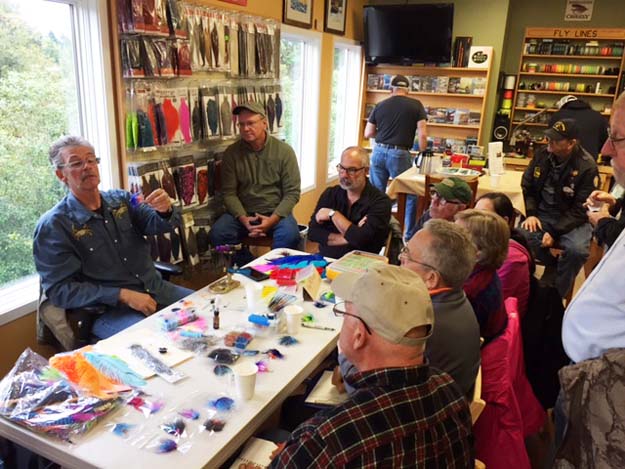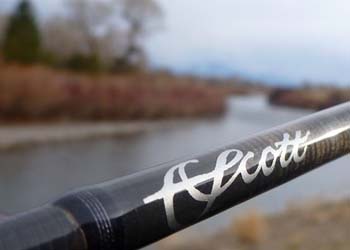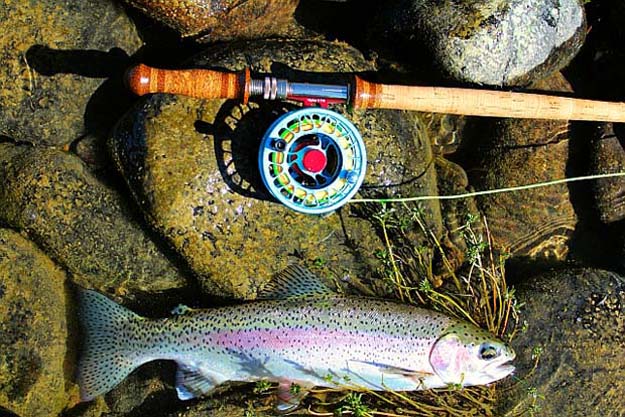
Another back-lit photo at the Tyer’s Table on Saturday’s. “I had a great time with all the questions from folks gathered,” Jay Nichols – Caddis Fly Shop.
With great oddity noted, fly rod reviews tend to be owned by those “out west,” people who are consumed with long, long Spey rods and fishing for steelhead. They seem only to have interests in 5-weights for single handed casting and discussion about them. I’m still not sure what they do with their 5-weights.
Serendipitously, and with an addiction to producing unsellable self-tied flies, I found Jay Nichols’ fly tying videos. They are excellent. Then I discovered his fly shop, Caddis Fly Shop which subsequently led me to what I was searching for. A good review on switch rods in the price range nearer to my bank account.
NOTE: We’ve excerpted, modified and adapted the story but provide a link for those who wish to read the complete and original review.
Why consider a Switch Rod?
By Jay Nicholas
[dropcap]I[/dropcap]started out in the 60s and 70s fishing 9-foot single hand rods for steelhead and salmon, with the occasional 10-footer in the mix, but the longer rods were often ungainly and awkward to handle all day long. At some point, I discovered Spey rods, well after most everyone else here in the region. The rods I worked with in the 80s and 90s were longer (14-15 ft) and were beastly things to fish especially with my lacking skills. Time passed, and the rods and line systems improved considerably, with manufacturers introducing shorter Spey rods that were lighter but still capable of making very long casts.
Sometime after 2000, you could purchase very good 8-weightt Spey rods at 12.5- to 13.5-feet that were light and great casting rods. The standard seemed to settle in with 6-weight rods being under 13-feet, 7-weight rods being 13-feet but under 14-feet, and 8-weight Spey rods pushing around the 13.5- to 14-feet.
Well, the longer Spey rods were (and still are) fine fishing tools when wading out in nice gravel studded runs with plenty of back casting room for forming D loops. When fishing in places with trees or rocks close behind, as is often the case on our coastal rivers, these longer rods are not nearly as much fun to maneuver.
Switch rods cometh

Tim Rajeff, owner of ECHO Fly Rods never seems to slow down. See him at a show, in a hotel lobby, giving a speech, donating time to Fish Need Water, competing internationally in a casting tournament – he’s boundless. Click on image to visit his charity – Fish Need Water.
Enter the Switch rods, offered at somewhere between the old 10-foot mark of the long single hander – and the 12-foot mark usually occupied by 5- or 6-weight Spey rods.
The switch rods in the generic 11-foot class offer a superior option when fishing with tree branches overhead or close behind. They also make a great beach, boat, and estuary fishing rods that may be fished overhead or with traditional Spey style casts.
I have watched many anglers struggle with longer Spey rods when fishing close quarters, and often loaned them my Switch rods to play with. The result is always the same – they want to add a Switch rod to their tool box. The question then becomes, which rod to recommend.
Daddy Warbucks? No. A pleasant reality? Yes
The high-end customer has several options that are all good, but not everyone has nine hundred bucks to drop on yet another fishin’ pole. So I have devoted considerable effort to exploring a range of mid-price options for the angler who is about to delve into the Switch rod world for the first time.
The Switch rods I’m reviewing in this post are three excellent rods that I’ve fished extensively this recent winter steelhead season. I’d venture that I’ve put in at least 36 hours fishing each of the three rods. Six hours fishing per day with an equal time of two hours per rod… each day.
I have fished other days with other Switch rods also, but none were as pleasing as these three. They meshed well with my modest casting ability, considerable bad casting habits, and personal quirks.
 When people come to me and ask about purchasing a modestly priced switch rod – these are the three I recommend without reservation
When people come to me and ask about purchasing a modestly priced switch rod – these are the three I recommend without reservation
My attraction to these three rods is based on serious time on the river, not an hour or an afternoon. Day after day trudging up and down the river banks, falling in, stumbling, smacking my rod tip into the overhanging brush (all three rods took a lot of punishment), wrapping flies around the rod when I placed my anchor poorly, and even a few steelhead hooked, lost, and released.
Mid-range

Redington Chromer Switch Rods.
These three Switch rods are in what we refer to the mid-price range – meaning that there are rods that cost less and far more than these. The Sage ONE is an excellent high-end rod as are the Sage Method, Scott T3H Premium, and Burkheimer Switch rods (we’re adding R. B. Meiser’s to that class).
NOTE: These Switch rods are all very good, but I wanted to keep this review focused on mid rather than high-end rods.
Redington Chromer Switch rod . . .
Price: ECHO is just over five bills, the Scott is about halfway north of five bills, and the Redington a tad less expensive at roughly four hundred bucks.
Length: ECHO is an even 11-feet while the Scott and Redington are both 11-foot 6-inches.
Action: All are what I consider fast action rods with soul, meaning that they are in a different class than rods like the Echo Dec Hogan II, a full action Burkheimer, or a modern glass rod. When I say these have a soul, that means that I can feel them load as I’m casting. All three rods are fast but comfortably fast.
Distance casting: All are very versatile. I always start by making casts with only my sink tip out of the guides, and gradually lengthen the reach of my swing as I prospect a run. All three of these rods have allowed me to make very long casts and very short precise casts whether I’m wading out in an open run or hunkered under trees dodging tree branches. As far as I’m concerned, there was never a situation when I was incapable of covering the water because of casting distance limitations – other than my limitations.
All of these rods will deliver your fly to the farthest reach of our coastal rivers with ease
Line matches: I fished a 6-weight in the Chromer Switch and a 7-weightin the Scott and Echo rods. Both 7-weights cast an Airflo Compact Switch Skagit at 450 grain, but I fished an OPST Commando 375-grain head on both rods more often than not. The 6-weight Chromer fished spectacularly with a 420-grain Compact Switch or a 325 OPST Commando.
Sink Tips: I fished 10-foot RIO Mow tips in T-11 and T-14. I also fished AIRFLO Flo tips in T-10 and T-14. I found it uncomfortable when I tried the 12-foot T-14 tips with these lines and rods, but otherwise, they were all up to the task of throwing T-10 to T-14.
Handle: The handles on these rods are different but similar, and I’ll have difficulty in this discussion, but here goes.
16.75-inches: The Scott L2H is the shortest handle of the three rods and is very subtly different with the bulges at lower and upper top grip. For my hands and my casting style, I preferred this handle configuration over the other two handles.
17.25-inches: The Echo 3 Switch rod has the middle length handle, and I would characterize this as the most generic shape of the three. A good handle overall.
17.75-inches: The Redington Chromer handle is the longest of the three rods and is unique insofar as the rubber tip on top and bottom hand. While the handle overall is a little thinner than I’d prefer, I found that I liked the feel of the rubber tips so much that I was swayed towards this handle.
Hardware: All three rods have good hardware . . .
NOTE: Featured Image Thompson River rainbow trout with 11-foot R.B. Meiser switch rod. Photo courtesy R. B.Meiser Fly rods.


